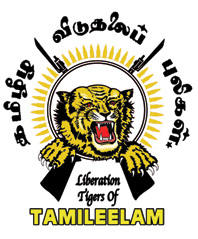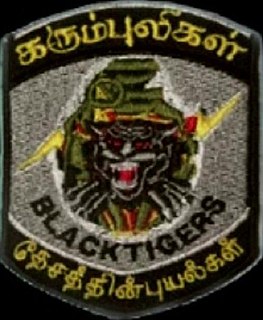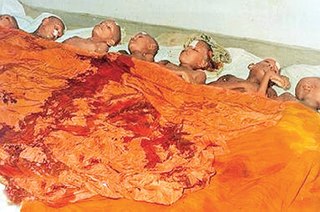
The Liberation Tigers of Tamil Eelam was a Tamil militant organization that was based in northeastern Sri Lanka. The LTTE fought to create an independent Tamil state called Tamil Eelam in the north-east of the island, due to the continuous discrimination and violent persecution against Sri Lankan Tamils by the Sinhalese dominated Sri Lankan Government.

The Sri Lankan Civil War was a civil war fought in Sri Lanka from 1983 to 2009. Beginning on 23 July 1983, there was an intermittent insurgency against the government by the Velupillai Prabhakaran-led Liberation Tigers of Tamil Eelam. The LTTE fought to create an independent Tamil state called Tamil Eelam in the north-east of the island, due to the continuous discrimination and violent persecution against Sri Lankan Tamils by the Sinhalese dominated Sri Lankan Government.

The Black Tigers was an elite suicide commando unit of the Liberation Tigers of Tamil Eelam (LTTE), a militant Tamil separatist organization.
The Anuradhapura massacre occurred in Sri Lanka in 1985 and was carried out by the Liberation Tigers of Tamil Eelam. This was the largest massacre of Sinhalese civilians by the LTTE to date; it was also the first major operation carried out by the LTTE outside a Tamil majority area. Initially, EROS claimed responsibility for the massacre, but it later retracted the statement, and joined the PLOTE in denouncing the incident. The groups later accused the LTTE for the attack. Since then, no Tamil militant group has admitted to committing the massacre. However, state intelligence discovered that the operation was ordered by the LTTE's leader Velupillai Prabhakaran. He assigned the massacre to the LTTE Mannar commander Victor and it was executed by Victor's subordinate Anthony Kaththiar. The attack was allegedly sparked by the 1985 Valvettiturai massacre, where the Sri Lanka Army massacred 70 Tamil civilians in Prabhakaran's hometown.

Eelam War II is the name given to the second phase of armed conflict between Sri Lankan military and the separatist Liberation Tigers of Tamil Eelam. The war started after the failure of peace talks between the Premadasa government and the LTTE. This phase of the war was initiated by the LTTE who massacred almost 600 Sinhalese and Muslim police personnel after they were ordered by the Premadasa government to surrender to the LTTE. The truce was broken on June 10, 1990 when the LTTE in October expelled all the 28,000 Muslims residing in Jaffna.

The Tamil Eelam Air Force or Sky Tigers was the air-wing of the Liberation Tigers of Tamil Eelam (LTTE), who used it against the Government of Sri Lanka. They also called themselves the Tamileelam Air Force (TAF). Though the existence of the Sky Tigers had been the subject of speculation for many years, the existence of the wing was only revealed after an attack in March 2007, during Eelam War IV.

Eelam War IV is the name given to the fourth phase of armed conflict between the Sri Lankan military and the separatist Liberation Tigers of Tamil Eelam (LTTE). Renewed hostilities began on the 26 July 2006, when Sri Lanka Air Force fighter jets bombed several LTTE camps around Mavil Aru anicut. The government's casus belli was that the LTTE had cut off the water supply to surrounding paddy fields in the area. Shutting down the sluice gates of the Mavil Aru on July 21 depriving the water to over 15,000 people - Sinhalese and Muslim settlers under Sri Lankan state-sponsored colonisation schemes in Trincomalee district. They were denied of water for drinking and also cultivating over 30,000 acres of paddy and other crops. The fighting resumed after a four-year ceasefire between the Government of Sri Lanka (GoSL) and LTTE. Continued fighting led to several territorial gains for the Sri Lankan Army, including the capture of Sampur, Vakarai and other parts of the east. The war took on an added dimension when the LTTE Air Tigers bombed Katunayake airbase on March 26, 2007, the first rebel air attack without external assistance in history.

The Aranthalawa massacre was the massacre of 33 Buddhist monks, most of them young novice monks, and four civilians by cadres of the Liberation Tigers of Tamil Eelam organization on June 2, 1987, close to the village of Aranthalawa, in the Ampara District of Eastern Sri Lanka. The massacre is among the most notorious and devastating atrocities committed by the LTTE during the history of the Sri Lankan Civil War, and continues to be commemorated 35 years on.
The Havelock Road Bombing was the detonation of a remote controlled car bomb on March 2, 1991, during rush hour in Thimbirigasyaya a suburb of Colombo, Sri Lanka. According to Jane's Information Group it was carried out to assassinate Ranjan Wijeratne, the Sri Lankan Foreign Minister and Minister of State for Defense by the Liberation Tigers of Tamil Eelam (LTTE) which was an organization fighting for Tamil rights in the country. The bomb was detonated as the Minister's armored car passed it, killing 19 people including the minister, five security personal and 13 civilian by standers. Minister Wijeratne was known to have a hard line stance towards the LTTE.

On February 20, 2009, the air wing of the Tamil Tigers separatist militia launched a suicide attack against military locations in and around Colombo, Sri Lanka, using two weaponized light aircraft. It is speculated that the raids were intended to mimic the September 11 attacks, where aircraft were used as flying bombs and crashed directly into their targets. The attackers failed to reach their presumed targets and crashed to the ground after being shot down by the Sri Lanka Air Force, although one of the aircraft struck a government building in Colombo, killing two people, and over 50 people in total were injured in both crashes.

The Temple of the Sacred Tooth Relic or Sri Dalada Maligawa, is a Buddhist temple in Kandy, Sri Lanka. It is located in the royal palace complex of the former Kingdom of Kandy, which houses the relic of the tooth of the Buddha. Since ancient times, the relic has played an important role in local politics because it is believed that whoever holds the relic holds the governance of the country. The relic was historically held by Sinhalese kings. The temple of the tooth is a World Heritage Site mainly due to the temple and the relic.
1989 Temple of the Tooth attack is an attack on the Temple of the Tooth Relic, located in Kandy, Sri Lanka. The shrine, which is considered to be important to the Buddhists in Sri Lanka, houses the relic of the tooth of the Buddha, and is a UNESCO designated World Heritage Site. It was attacked on 8 February 1989, allegedly by the armed cadres affiliated to Janatha Vimukthi Peramuna (JVP), a Marxist-Leninist Communist political party in Sri Lanka.

1998 Temple of the Tooth attack is an attack on the Temple of the Tooth Relic, located in Kandy, Sri Lanka. The shrine, which is considered to be important to the Buddhists in Sri Lanka, houses the relic of the tooth of the Buddha, and is also a UNESCO designated World Heritage Site. In 1998, it was attacked by Liberation Tigers of Tamil Eelam (LTTE), a separatist militant organization which fought to create an independent Tamil state in Northern and Eastern parts of the country, from 1983 to 2009.
Terrorism in Sri Lanka has been a highly destructive phenomenon during the periods of the Sri Lankan Civil War (1983–2009) and the first and second JVP insurrections. A common definition of terrorism is the systematic use or threatened use of violence to intimidate a population or government for political, religious, or ideological goals. Sri Lanka is a country that has experienced some of the worst known acts of modern terrorism, such as suicide bombings, massacres of civilians and assassination of political and social leaders, that posed a significant threat to the society, economy and development of the country. The Prevention of Terrorism Act of 1978 is the legislation, that provides the powers to law enforcement officers to deal with issues related to terrorism in Sri Lanka. It was first enacted as a temporary law in 1979 under the presidency of J. R. Jayewardene, and later made permanent in 1982.








